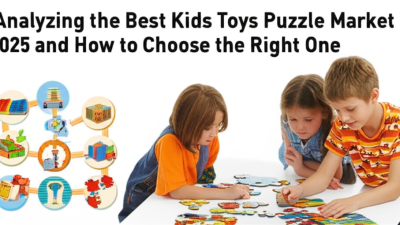Analyzing the Best Kids Toys Puzzle Market in 2025 and How to Choose the Right One
In the ever-evolving world of children's playtime, the market for Kids Toys Puzzle is set to thrive in 2025, offering an array of options that not only entertain but also educate. As parents and caregivers become increasingly discerning about their children's play experiences, understanding how to choose the right puzzle becomes essential. With countless designs, materials, and themes available, selecting a puzzle that aligns with a child's age, interests, and developmental needs can seem daunting. This blog will delve into the best Kids Toys Puzzle trends anticipated for 2025, providing insightful tips on how to navigate this dynamic market. By focusing on educational values, durability, and engagement, we aim to equip parents with the knowledge needed to make informed choices that foster creativity and cognitive growth in their little ones.
The Growing Importance of Educational Toys in Child Development
The growing significance of educational toys in child development cannot be overstated, particularly as the market for such toys is projected to witness exponential growth. By 2025, the global educational toy market is expected to reach approximately $71.32 billion, escalating to $126.02 billion by 2032 at an impressive compound annual growth rate (CAGR) of 8.47%. This surge reflects a palpable shift towards toys that not only entertain but also educate, crucial for fostering cognitive and social skills in children.
Amid this expansion, STEM (Science, Technology, Engineering, and Mathematics) toys are becoming increasingly popular. The global STEM toy market is anticipated to grow from $6 billion in 2024 to $13.1 billion by 2032, driven by a burgeoning interest in enhancing children’s problem-solving abilities and critical thinking skills. Likewise, the market for intelligent AI toys is on the rise, predicted to increase from $250 million in 2022 to $1.12 billion by 2030. This trend highlights a clear consumer demand for toys that integrate advanced technologies, thereby supporting children’s learning experiences in an increasingly digital world.
Trends Shaping the Kids Puzzle Market in 2025
As we approach 2025, the kids puzzle market is evolving rapidly, influenced by various trends that cater to the changing preferences of young learners. One of the most notable trends is the rise of smart learning and interactive play, which is transforming educational toys into engaging tools that promote cognitive development. Puzzle games are no longer just a means of entertainment; they are becoming integral to educational curriculums, making learning fun and interactive for children. This shift not only enhances their problem-solving skills but also aligns with the latest school trends focused on active engagement.
Additionally, there is a notable increase in the demand for brain-stimulating activities, which has propelled the jigsaw puzzles market forward. Parents are increasingly seeking toys that promote cognitive entertainment, contributing to a steady growth expected through 2032. This emphasis on mental stimulation is echoed in the growing popularity of puzzles in mobile games, ranking high in revenue and usage statistics. As the market for kids puzzles continues to expand, it is essential for parents to choose products that not only align with their children's interests but also foster educational growth in a playful manner.
Kids Puzzle Market Trends Analysis 2025
Key Features to Look for in Quality Kids Puzzles
When selecting quality kids' puzzles, several key features should be considered to ensure both enjoyment and educational value. First and foremost, the material of the puzzle is crucial. Opt for non-toxic, durable materials like wood or high-quality cardboard that can withstand the wear and tear of enthusiastic little hands. These materials not only enhance durability but also ensure safety during playtime, eliminating any concerns about harmful chemicals.
Another important aspect to look for is the puzzle size and piece count. For younger children, larger pieces made for smaller hands are ideal, preventing frustration and encouraging independence in problem-solving. As kids grow, gradually introducing puzzles with more pieces and intricate designs can help develop their cognitive skills and fine motor abilities. Additionally, consider puzzles that feature vibrant colors and engaging images, as these can captivate a child's interest and make learning an enjoyable experience.
Safety Standards and Materials for Children's Puzzles
When choosing puzzles for children, safety should always be the top priority. In 2025, the market is expected to emphasize compliance with strict safety standards, ensuring that materials used in puzzles are non-toxic and free from harmful chemicals. Look for labels that indicate adherence to safety regulations such as ASTM or EN71, which reflect the product's safety for kids. This helps in selecting toys that not only provide fun but also safeguard children's health.
Tips for parents include examining the material quality of puzzles. Opt for puzzles made from high-density cardboard or sustainably sourced wood. These materials are not only durable but also safer for children to handle. Additionally, be mindful of age recommendations; puzzles intended for older kids often include smaller pieces that pose choking hazards for younger children. By carefully assessing these factors, you can ensure that you choose the perfect puzzle that engages your child while keeping them safe.
Tips for Choosing the Perfect Puzzle for Different Age Groups
When selecting the perfect puzzle for children, age appropriateness is key. For toddlers aged 1 to 3, choose puzzles with large, chunky pieces that are easy to handle and safe to chew on. These puzzles often feature colorful images of animals or everyday objects that help develop their recognition skills and hand-eye coordination. At this age, a simple 2- to 5-piece design is ideal, fostering a sense of accomplishment as they complete each puzzle.
As children grow into preschoolers, typically ages 4 to 5, they can handle more complexity. Look for puzzles with 12 to 24 pieces that challenge their problem-solving abilities without causing frustration. Themes such as dinosaurs, space, or favorite cartoon characters can capture their interest, encouraging them to engage with the puzzle longer. For older children, ages 6 and up, consider puzzles with 50 pieces or more, incorporating different shapes and unique designs. These not only enhance cognitive skills but also provide a great opportunity for family bonding as they work together to complete the puzzle.
Analyzing the Best Kids Toys Puzzle Market in 2025
| Age Group |
Puzzle Type |
Number of Pieces |
Recommended Duration (minutes) |
Skill Development Focus |
| 2-3 years |
Chunky Puzzles |
4-8 pieces |
10-15 |
Motor Skills, Shape Recognition |
| 4-5 years |
Floor Puzzles |
24-48 pieces |
20-30 |
Spatial Awareness, Problem Solving |
| 6-8 years |
Jigsaw Puzzles |
100-300 pieces |
30-60 |
Critical Thinking, Attention to Detail |
| 9-12 years |
Advanced Puzzles |
500+ pieces |
60-120 |
Patience, Strategy Planning |



